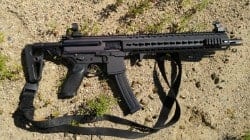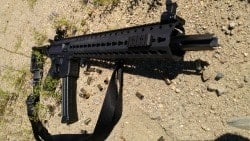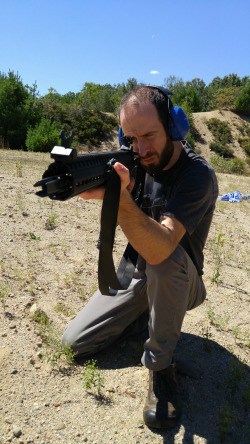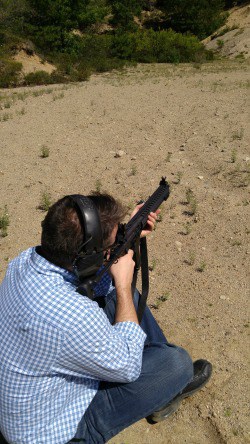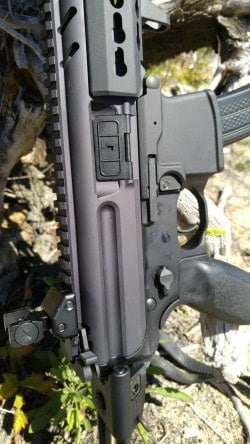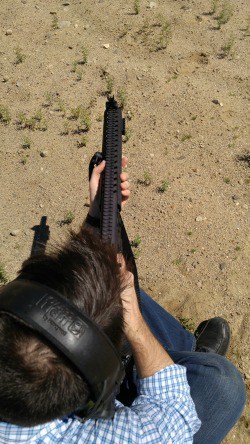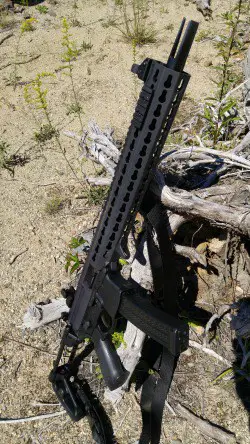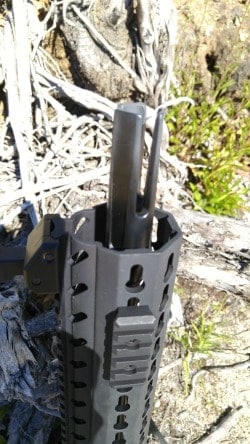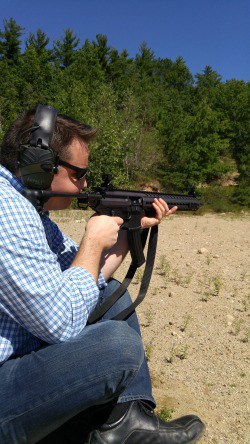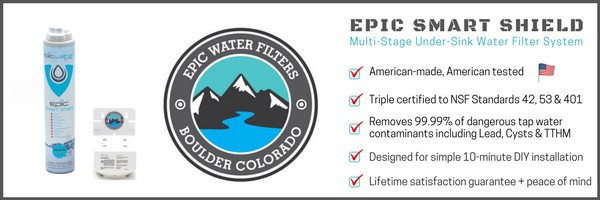I was fortunate enough to be able to have some trigger time recently with a Sig Sauer MPX-C 9mm
SKIP AHEAD
A Quick Overview of the MPX
The Sig Sauer MPX family of guns is a modern take on the submachine gun class of firearms that started with the
The Sig Sauer MPX, on first glance, appears to be a conglomeration of an AR-15 and an MP5. Take the upper/lower receiver design of an AR, along with the AR’s charging handle, control placement, and general order of operations, then combine with a short magazine well and collapsible stock from an MP5, and you’ll have a pretty good idea of what an MPX looks and feels like. All of the MPX’s controls are fully ambidextrous – including the magazine release, charging handle, and bolt stop – usually rarities from the factory on an AR platform.
Read More: AR-15 Magazine Management Strategies
The operating system is still gas-operated, even with the comparatively low-intensity 9mm round. It’s a short-stroke
The Sig Sauer MPX platform sports an innovative free-floating rail with keymod attachment points, that interfaces into the upper receiver with a slick groove setup – and it is completely removable with no tools required. Once one pushes out the forward takedown pin, the rail is unlocked and is free to slide forward and off the gun. ost AR type handguard rails are clamped on the barrel nut with set screws in some fashion or another; the MPX’s system is slick and clean with no extra hardware needed. Rest assured that it is solid enough for a sighting system to be mounted; at the range I pulled the rail off the gun and reinstalled several times between magazines, and the sights’ point of impact remained unaffected.
Speaking of the sights, The Sig Sauer MPX comes standard with Sig Sauer’s line of folding iron sights, but the full-length picatinny rail in the top of the rifle, combined with the keymod accessory mounting points, allow you to mount your choice of optics, red dots, lasers, flashlights…you know the drill. Overall, the Sig Sauer MPX-C that I tried did not leave the user wanting or needing to modify the gun with aftermarket go-fast gadgets; the gun already comes ready to rumble once you add your accessories. It ought to; the MSRP of this little beast is just a bit over $2,000. Luckily, if you can find them on the open market, they usually bring between $1,600-$1,800.
The Sig Sauer MPX-C model I was able to test had a 16-inch overall barrel length, the last 2 inches or so of which was
The MPX also comes in much shorter and alternate configurations, some of which you’d need tax stamps for. For further information on other MPX setups, you can visit their MPX site here. The rumor is that the MPX platform is made to be modular, with easy-to-change barrel/bolt setups, so one can swap the 9mm barrel out for a higher-horsepower .40 S&W or .357 Sig setup. I didn’t test this personally, but it makes sense, with the increasing demand for modularity in the firearms world today.
Shooting The MPX-C
I only had the Sig Sauer MPX for a couple of quick range visits, so like I said, I can’t give you a full, strong overview of the system, with multiple different loads including handloads, across a spectrum of distances. I was able to run three different loads through the MPX: Federal American Eagle 115 grain FMJ, PMC “Bronze” 115 grain JHP, and Sig Sauer’s own Elite V-Crown 124 grain JHP, the defense round I use in my carry guns.
Once I got to the range, I deployed my gear and let the others at the range “ooh” and “aah” all over the MPX. The rifle does draw a crowd, and when handling the gun and admiring the fit, finish and the overall quality the gun exudes, well, I must say it deserves every bit of drool and coveting that is a consequence of its very presence.
Also Read: Survival Gear Review Talon Grips
Once show and tell was over, I stuffed one of the two 30-round translucent polymer magazines full with the little
I shouldered the rifle, and happily peered through the standard flip-up sight picture. And I squeezed the trigger. And squeezed. And pulled. The second surprise of the day came from the vicious, gritty trigger pull of a $2,000 rifle. What the hell? Expecting a fine-tuned machine and discovering a heavy, ugly trigger pull wasn’t what I’d come to expect from Sig Sauer – especially at this price point. I ended up inadvertently yanking the trigger and the round nose-dived into the lower edge of the target, 25 yards away.
Surprise number three came as soon as the trigger decided it would actually go off: BRIIINNNGGGGGG. The Sig Sauer MPX fired the round and cycled as it should, but the cool-looking, probably-maybe-effective three-pronged muzzle brake rang like a tuning fork that had been tapped on a steel plate. And it didn’t stop immediately; I had to reach out and physically grab the muzzle device to make it cease and desist the F sharp or whatever the hell note it rang. I pulled the magazine, jacked the round out of the chamber, so I could safely inspect the muzzle brake – and I noticed that just cycling the action of the MPX made hell’s bells ring again. Interesting – and I was rather taken aback that this was a feature that Sig Sauer let roll out the door. I checked the brake – it was pinned and welded properly and legally. I don’t know if this is the way all factory MPX muzzle brakes work, but I know this one did – and damn, was it annoying.
I ripped off the rest of that one magazine just to have some fun, but then put the MPX away for the afternoon to focus on the guns I brought with me that had nice trigger pulls, and the only noise they made was “bang”.
Nurse, SCALPEL!
At day’s end, the owner of the MPX met back up with me, and we retired to my man cave to see what we could do
…and I was tickled pink to find out that the innards of the MPX’s fire control group are identical to an AR-15. That was a shrewd move on Sig’s part – if you want to drop in a Timney or Geiselle other such aftermarket trigger group, you just need to find the standard AR-15 parts…no proprietary parts searching, or waiting for the aftermarket to adopt the particular platform…if the aftermarket adopts it at all. Probably helps with inventory on Sig’s end, too, since Sig Sauer offers a full line of AR type rifles, as well as their new MCX rifle.
I pulled the basic fire control group out of the MPX’s lower, and treated the appropriate parts and areas to a nice loving 2500-grit polish. A liberal coating of bearing surfaces with TW-25B grease (I love that stuff) completed the package. About 45 minutes and an adult beverage later, I re-assembled the MPX’s lower and was pleased to find a nice, smooth trigger pull that weighed, by my guess, about 6-7 pounds. There was zero grittiness, and the pull was acceptable and useful for a MILSPEC type trigger. I didn’t touch any springs or remove any metal other than what was polished, so the trigger pull weight was largely unaffected.
Second Time’s a Charm
We hit the range again a few days later to finish sighting in the MPX and to do some more testing. I couldn’t do
We dialed the gun in using the American Eagle 115 FMJ ammunition, since he has a readily available supply of this fodder. We sighted the rifle in at 50 yards per the owner’s wishes. The windage was spot-on from the factory, with just the front sight needing to be adjusted. My Real Avid AR tool came in handy to get the front sight to the desired elevation, and we were soon in business. Offhand, we were consistently getting 2” five-shot groups at 50 yards with the American Eagle ammunition. From the bench, we were able to tighten it up and pull in regular 1 ½” groups with the stock iron sights. Accuracy was very good; I’m sure if one was to run several ammunition makes with varying bullet weights, you could find a load that performed better. But the owner was very happy, and that’s what counted in this particular instance. 100-yard offhand fun shots at milk jugs were a hoot, with every shot connecting offhand once we got the “Kentucky windage” dialed in for the added distance.
We ran a few PMC “Bronze” 115 JHPs (I only had one box with me) to test function, group size, and velocity. The MPX fed the more open hollowpoint with nary a burp, though group sizes opened up to about 2 ½” at 50 yards, benched. I borrowed a few Sig V-Crown Elite 124 grain JHP rounds from my Sig P320 carry magazines for function, group, and velocity as well. These turned in the best group (just over 1 inch across, a ragged 5-shot hole) and functioned beautifully as well.
Overall, my time spent behind the trigger of the SIg Sauer MPX-C was thoroughly enjoyable. The gun shot quite well with open sights, and we had zero malfunctions over about 200 rounds. Not much of a long-term test, but one hell of a promising start.
Check Out: Buying SHTF ammo
Is a 9mm Carbine Worth It?
So, after having run a full-sized 9mm Sig Sauer MPX-C for a little while and having crunched some performance numbers out of the ammunition to compare a 9mm carbine to a 9mm pistol, I personally have to wonder if the 9mm carbine is worth the added bulk. The performance gains over the handgun just weren’t as high as I’d thought they would be. I’ll get into this further in another article – but for those of you like myself, who geek out over such things, I present the following data:
Federal American Eagle 115 grn FMJ:
Sig MPX average muzzle velocity: 1,321 fps
Sig MPX average muzzle energy: 446 ft. lbs.
Sig P320 average muzzle velocity: 1,113.3 fps
Sig P320 average muzzle energy: 317 ft. lbs.
Difference: 208.31 fps / 129 ft. lbs.
Difference per inch of barrel length: 19.65 fps/12.17 ft. lbs per inch of barrel
PMC Bronze 115-grain JHP
Sig MPX average muzzle velocity: 1,238 fps
Sig MPX average muzzle energy: 392 ft. lbs.
Sig P320 average muzzle velocity: 1,052 fps
Sig P320 average muzzle energy: 283 ft. lbs.
Difference: 187.67 fps / 109 ft. lbs
Difference per inch of barrel length: 17.61 fps/ 10.2 ft. lbs per inch of barrel
Sig Sauer Elite V-Crown 124-grain JHP
Sig MPX average muzzle velocity: 1,315 fps
Sig MPX average muzzle energy: 476 ft. lbs.
Sig P320 average muzzle velocity: 1,105 fps
Sig P320 average muzzle energy: 336 ft. lbs.
Difference: 210 fps / 140 ft. lbs
Difference per inch of barrel length: 17.35 fps/ 11.6 ft. lbs per inch of barrel
For comparison’s sake, a 62-grain M855 5.56mm bullet, traveling at 2,900 feet per second out of an M4 carbine,
The other issue a potential purchaser would run up against is cost and accessories: When a new Sig Sauer MPX will run you $1,800, and then use proprietary magazines, you have to look long and hard at the system. If the MPX ran with P226 or c, I could see some definite appeal and justification on the price – you could stock one type of magazine for your carbine and your sidearm. But it doesn’t, so you can’t. This is a logistics conundrum you would have to figure out for your own SHTF/survival setup if you want to integrate a 9mm carbine into “the plan”.
For yuks ‘n’ giggles, I priced out a build using a Palmetto State Armory 9mm billet lower that accepts Glock 17/19 magazines. If you want to buy a pre-assembled upper and a pre-assembled lower through PSA, you can have a bare-bones 9mm carbine that feeds from Glock magazines for between $650-$900, depending on the configuration you like. You could upgrade to a couple Magpul accessories and throw an Aimpoint T-2 on top of it, and still have enough money left over from your Sig Sauer MPX fund to take the wife out someplace nice for dinner.
If you wanted to go higher-end than PSA and you have the ability to assemble an AR from parts, you could do a ground-up build using the PSA billet lower and high-end aftermarket parts to the tune of $1,200, no optics. Just something to consider, especially if you’re running a No products found..
I’m not trying to downplay the Sig Sauer MPX, but rather show that there are other options out there that will to the same thing for less money. However, what you will not have is Sig Sauer’s stellar customer service, unreal build quality, superb reliability, and the smug satisfaction that you have the best of the best protecting you. Your call.
Wrapping It Up
I thoroughly enjoyed every second I spent with the Sig Sauer MPX-C. It is a thoroughly thought-out platform,
Where the Sig Sauer MPX-C would really shine is running with a suppressor and subsonic ammunition. A fast, light, quick-handling carbine that is quiet is definitely an arm that would be the pride and joy of any survivalist/prepper’s arsenal. This would go doubly if you lived in an environment where you would be indoors much of the time or clearing houses/apartments or other similar tight spaces. Even without a suppressor, the blast of a 9mm carbine is timid compared to a 5.56mm carbine or shotgun if you have to pull the trigger indoors.
However, even for a high-end system that will run you towards $2,000, it does have a couple caveats – that miserable trigger and the singing muzzle brake. Replacing these parts with items that are equal to what SHOULD have come on a firearm with this price tag could set you back another $300 or more – then you add in the price of a few extra magazines ($60 a copy) a high quality optic (at least $300 before mounts), and suddenly you’re sneaking up on 3 grand without even blinking. Considering that you could build/purchase two extremely badass AR-15s for that price tag, you have to think long and hard about your situation and whether or not the Sig Sauer MPX is the perfect fit for your situation. If it is the perfect fit and money is no object, you can truly do no better. It’s worth every penny if you have the niche to fill and the dough to spend.
Questions or Comments – please make them below!!!
All Photos By Drew


